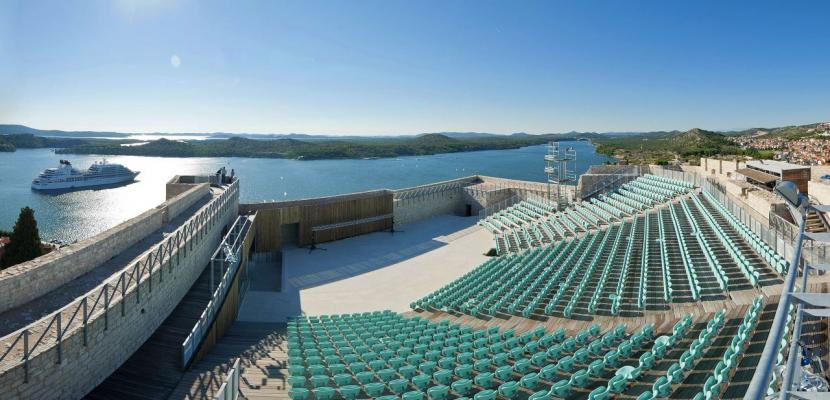Image

ST. MICHAEL'S FORTRESS – from an abandoned military relic to a regional cultural centre
Published on 04 January 2019

Croatia
Jadranska Hrvatska
This is the good practice's implementation level. It can be national, regional or local.
About this good practice
For 600 years, St. Michael's Fortress, the oldest historical site in the Croatian city of Šibenik, was closed to the public and was used for military purposes. Its interior, razed and used many times by different occupying armies, was a tabula rasa, a vast space without almost any preserved structures.
Starting in the 1950's, there was an idea to carefully convert this fortress into an open-air stage. Šibenik’s economy had suffered in the 90’s and to recover, the city started orienting itself towards cultural tourism. Thus, the old idea was once again raised at the end of the 2000's, and a preliminary design was made. With Croatian accession to the European Union approaching, some pre-accession EU funds were opened.
Finally, a project called Revitalization of St. Michael's Fortress applied for funding and was approved in 2012, with a goal “to contribute to the sustainable economic growth of Šibenik and the surrounding region through the development and broadening of cultural tourism“. Several studies and plans were prepared within the project, with educational and promotional activities being produced as well. St. Michael's Fortress was reopened on July 6th 2014.
Today, St. Michael’s Fortress holds a theatre seating 1077 spectators, with musical and theatrical performances held during the summer, benefitting residents and visitors. The fortress also serves as a museum and offers visitors spectacular views over the town, bay and islands.
Starting in the 1950's, there was an idea to carefully convert this fortress into an open-air stage. Šibenik’s economy had suffered in the 90’s and to recover, the city started orienting itself towards cultural tourism. Thus, the old idea was once again raised at the end of the 2000's, and a preliminary design was made. With Croatian accession to the European Union approaching, some pre-accession EU funds were opened.
Finally, a project called Revitalization of St. Michael's Fortress applied for funding and was approved in 2012, with a goal “to contribute to the sustainable economic growth of Šibenik and the surrounding region through the development and broadening of cultural tourism“. Several studies and plans were prepared within the project, with educational and promotional activities being produced as well. St. Michael's Fortress was reopened on July 6th 2014.
Today, St. Michael’s Fortress holds a theatre seating 1077 spectators, with musical and theatrical performances held during the summer, benefitting residents and visitors. The fortress also serves as a museum and offers visitors spectacular views over the town, bay and islands.
Expert opinion
The practice is an interesting example of valorisation of a cultural heritage asset which also plays a role for boosting cultural tourism at a city level. The learning potential is in the model that includes the establishment of an institution managing the historical monument on a daily basis and carrying out various functions such as scientific research, event organization, marketing and sales, technical management, project design and implementation. The practice demonstrated positive results, gained recognition and has been studied as a successful practice of conservation and valorisation of cultural heritage in Croatia.
Resources needed
The project cost 1.67M€, with 1M€ from the ERDF IPA IIIC BRI programme, the rest from the City of Šibenik. The City also funded other infrastructure works of almost 1M€.
Annual investments (signage, interpretation, archaeological works etc.), are from 50 to 100K €. Costs of events are additional.
Annual investments (signage, interpretation, archaeological works etc.), are from 50 to 100K €. Costs of events are additional.
Evidence of success
The Fortress of Culture Šibenik, the institution which manages the site, is self-sustainable and not dependent on the City funds. It has 25 permanent and 15 seasonal employees, and makes a wide economic effect (cooperation with local artists and cultural workers, SMEs and family farms).
Since July 2014, it has hosted about 100 evening concerts, with national and international performers.
The fortress also has 120,000+ visitors per year, and is one of the 10 top historical monuments in Croatia.
Since July 2014, it has hosted about 100 evening concerts, with national and international performers.
The fortress also has 120,000+ visitors per year, and is one of the 10 top historical monuments in Croatia.
Potential for learning or transfer
Fortress of Culture Šibenik won many national and professional awards, and the fortresses of Šibenik have been widely recognized as being among the most successful heritage valorization projects in Croatia. The management model – establishing an institution which has the human and financial resources to manage a historical, but also contemporary cultural monument on a daily basis (scientific research, event organization, marketing and sales, technical management, investments, project conception and implementation…) – has been accepted and studied in Croatia
Further information
Website
Good practice owner
You can contact the good practice owner below for more detailed information.
Organisation
City of Sibenik

Croatia
Jadranska Hrvatska
Contact
Head of Office